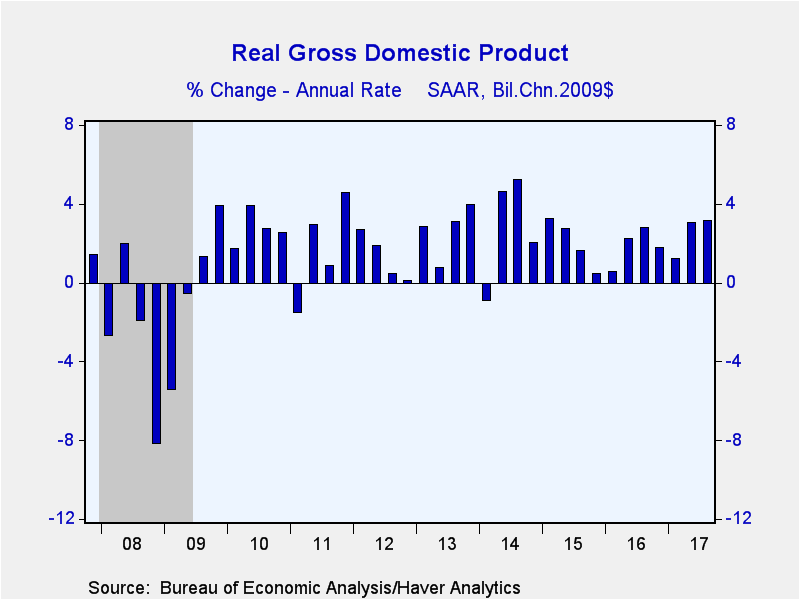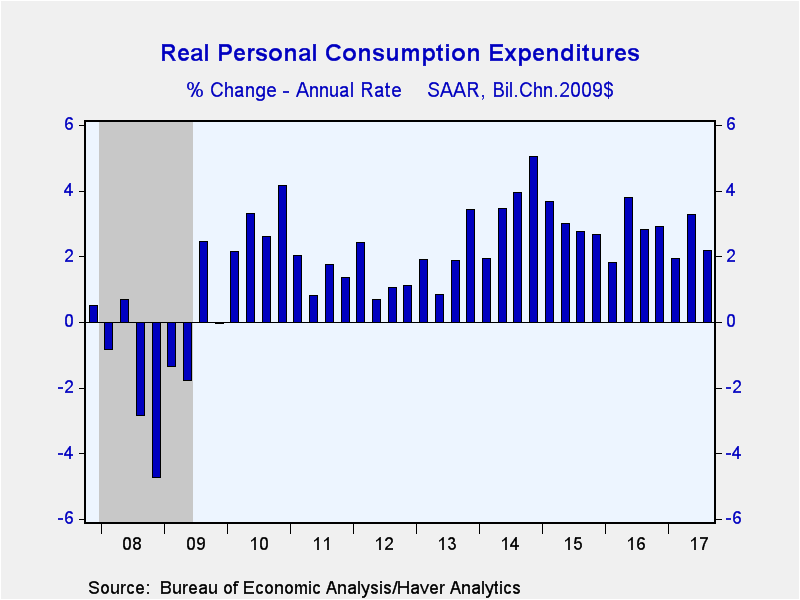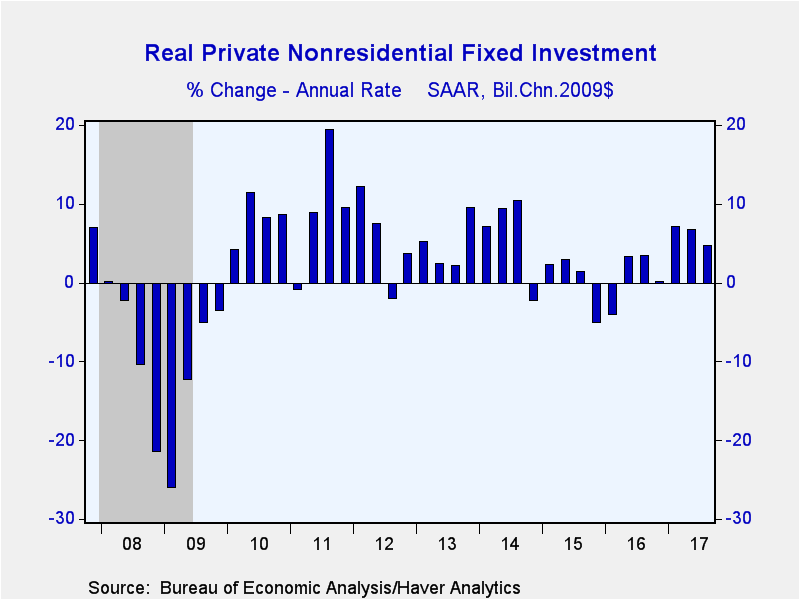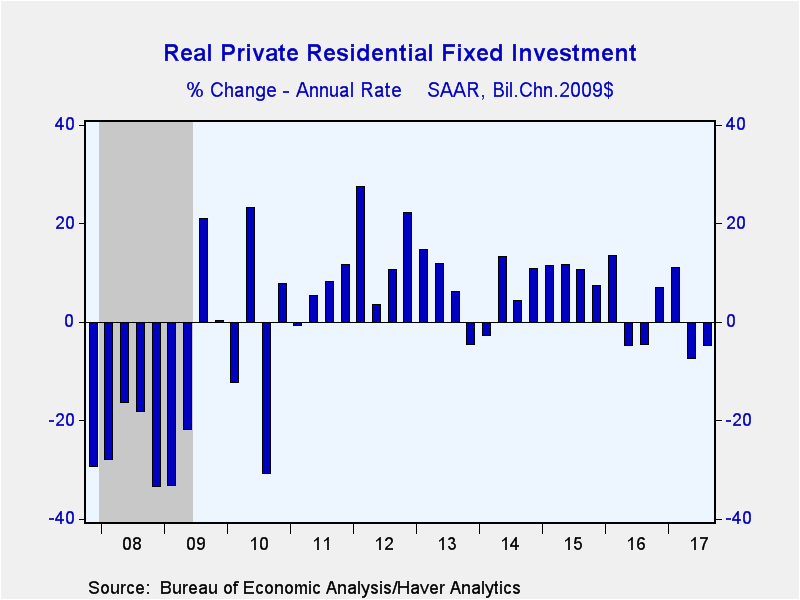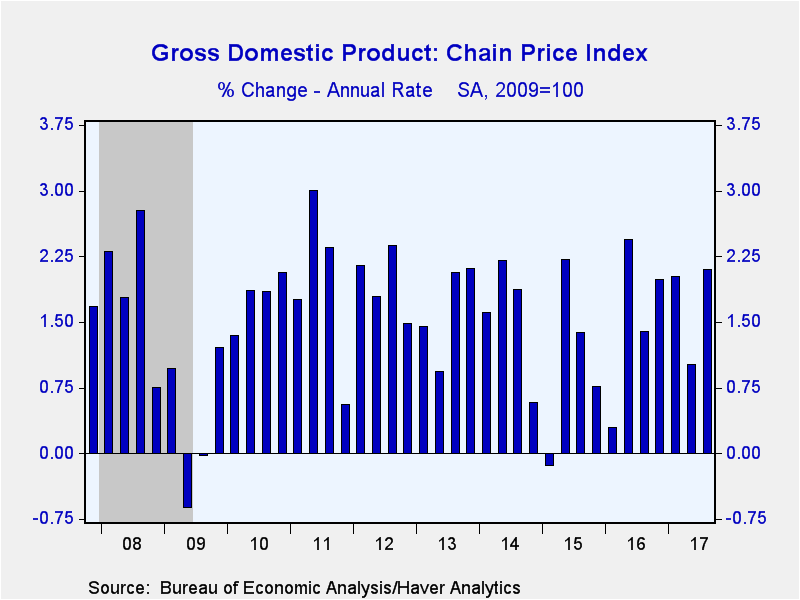 Global| Dec 21 2017
Global| Dec 21 2017U.S. GDP Growth Is Slightly Weakened
by:Tom Moeller
|in:Economy in Brief
Summary
Economic growth was revised to 3.2% (AR, 2.3% y/y) during Q3'17 from a 3.3% second estimate released last month. It was the strongest growth since Q1'15. Expectations had been for 3.3% growth in the Action Economics Forecast Survey. [...]
Economic growth was revised to 3.2% (AR, 2.3% y/y) during Q3'17 from a 3.3% second estimate released last month. It was the strongest growth since Q1'15. Expectations had been for 3.3% growth in the Action Economics Forecast Survey.
After-tax corporate profits increased 4.7% (9.8% y/y), revised from 4.9%. Profits without IVA & CCA gained 4.3% (5.4% y/y). Earnings in the domestic financial sector strengthened 10.8% while nonfinancial U.S. earnings improved 0.8%. Foreign sector profits increased 7.7%.
The change in business inventories added 0.8 percentage point to growth last quarter. Improvement in net exports added 0.5 percentage point. Both figures were unrevised. Exports grew 2.1% (2.2% y/y). Imports fell 0.7% (+3.2% y/y).
Domestic final sales growth was lessened to 1.9% (2.3% y/y) from 2.0%, and remained the weakest advance since Q1'16.
Consumer spending growth of 2.2% (2.6% y/y) compared to 2.3% estimated last month. Durable goods consumption grew 8.6% (6.3% y/y) as motor vehicle sales strengthened 12.2% (3.7% y/y). Spending on home furnishings and appliances grew 8.8% (7.0% y/y), but recreational goods purchases improved a lessened 0.8% (8.8% y/y). Nondurable goods consumption grew 2.3% (2.5% y/y). Gasoline & fuel oil consumption declined 2.3% (-0.7% y/y) while clothing purchases eased 0.3% (+1.7% y/y). Services spending grew 1.1% (2.0% y/y), the weakest quarterly gain in four years. Housing and utilities spending held steady (0.5% y/y). Recreation spending improved 0.4% (2.2% y/y) while restaurant & hotel expenditures rose 1.9% (1.0% y/y).
Business fixed investment improved an unrevised 4.7% (4.6% y/y). Equipment spending grew an increased 10.8% (6.4% y/y) as investment in information processing equipment rose 10.8% (8.1% y/y). Industrial equipment investment grew 7.6% (8.1% y/y) and intellectual property product investment improved 5.2% (3.5% y/y). Structures investment fell by 7.0% (+2.8% y/y).
Residential investment fell a lessened 4.7% (+1.2% y/y) following a 7.3% decline in Q2.
Government sector spending improved an increased 0.7% (-0.1% y/y). State & local government spending improved 0.2% (-0.1% y/y), revised from -0.1%. Federal government investment increased 1.3% (0.1% y/y). Defense spending grew 2.4% (0.1% y/y). Nondefense spending eased 0.3% (0.0% y/y), off for the third straight quarter.
The GDP price index rose an unchanged 2.1% (1.8% y/y). The personal consumption price index rose an unchanged 1.5% (1.5% y/y). The business fixed investment price index rose 1.1% (1.3% y/y).
The GDP figures can be found in Haver's USECON and USNA database. USNA contains virtually all of the Bureau of Economic Analysis' detail in the national accounts, including the integrated economic accounts and the recently added GDP data for U.S. Territories. The Action Economics consensus estimates can be found in AS1REPNA.
Tom Moeller
AuthorMore in Author Profile »Prior to joining Haver Analytics in 2000, Mr. Moeller worked as the Economist at Chancellor Capital Management from 1985 to 1999. There, he developed comprehensive economic forecasts and interpreted economic data for equity and fixed income portfolio managers. Also at Chancellor, Mr. Moeller worked as an equity analyst and was responsible for researching and rating companies in the economically sensitive automobile and housing industries for investment in Chancellor’s equity portfolio. Prior to joining Chancellor, Mr. Moeller was an Economist at Citibank from 1979 to 1984. He also analyzed pricing behavior in the metals industry for the Council on Wage and Price Stability in Washington, D.C. In 1999, Mr. Moeller received the award for most accurate forecast from the Forecasters' Club of New York. From 1990 to 1992 he was President of the New York Association for Business Economists. Mr. Moeller earned an M.B.A. in Finance from Fordham University, where he graduated in 1987. He holds a Bachelor of Arts in Economics from George Washington University.


